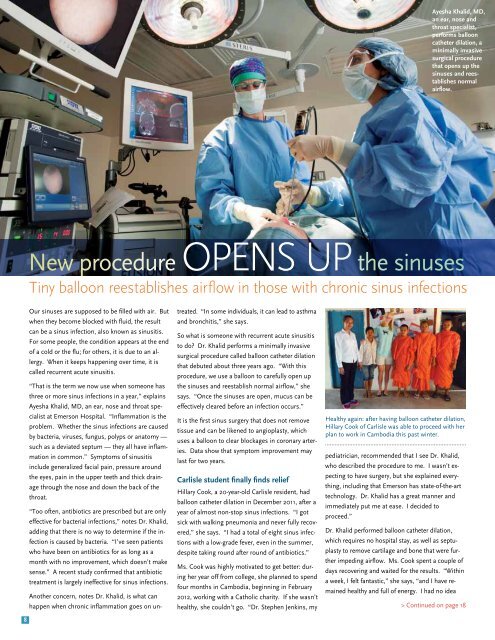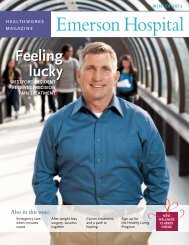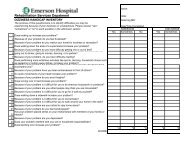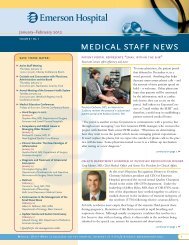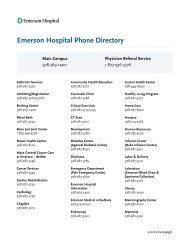Download PDF - Emerson Hospital
Download PDF - Emerson Hospital
Download PDF - Emerson Hospital
Create successful ePaper yourself
Turn your PDF publications into a flip-book with our unique Google optimized e-Paper software.
Ayesha Khalid, MD,<br />
an ear, nose and<br />
throat specialist,<br />
performs balloon<br />
catheter dilation, a<br />
minimally invasive<br />
surgical procedure<br />
that opens up the<br />
sinuses and reestablishes<br />
normal<br />
airflow.<br />
New procedure OPENS UP the sinuses<br />
Tiny balloon reestablishes airflow in those with chronic sinus infections<br />
Our sinuses are supposed to be filled with air. But<br />
when they become blocked with fluid, the result<br />
can be a sinus infection, also known as sinusitis.<br />
For some people, the condition appears at the end<br />
of a cold or the flu; for others, it is due to an allergy.<br />
When it keeps happening over time, it is<br />
called recurrent acute sinusitis.<br />
“That is the term we now use when someone has<br />
three or more sinus infections in a year,” explains<br />
Ayesha Khalid, MD, an ear, nose and throat specialist<br />
at <strong>Emerson</strong> <strong>Hospital</strong>. “Inflammation is the<br />
problem. Whether the sinus infections are caused<br />
by bacteria, viruses, fungus, polyps or anatomy —<br />
such as a deviated septum — they all have inflammation<br />
in common.” Symptoms of sinusitis<br />
include generalized facial pain, pressure around<br />
the eyes, pain in the upper teeth and thick drainage<br />
through the nose and down the back of the<br />
throat.<br />
“Too often, antibiotics are prescribed but are only<br />
effective for bacterial infections,” notes Dr. Khalid,<br />
adding that there is no way to determine if the infection<br />
is caused by bacteria. “I’ve seen patients<br />
who have been on antibiotics for as long as a<br />
month with no improvement, which doesn’t make<br />
sense.” A recent study confirmed that antibiotic<br />
treatment is largely ineffective for sinus infections.<br />
Another concern, notes Dr. Khalid, is what can<br />
happen when chronic inflammation goes on un-<br />
8<br />
treated. “In some individuals, it can lead to asthma<br />
and bronchitis,” she says.<br />
So what is someone with recurrent acute sinusitis<br />
to do? Dr. Khalid performs a minimally invasive<br />
surgical procedure called balloon catheter dilation<br />
that debuted about three years ago. “With this<br />
procedure, we use a balloon to carefully open up<br />
the sinuses and reestablish normal airflow,” she<br />
says. “Once the sinuses are open, mucus can be<br />
effectively cleared before an infection occurs.”<br />
It is the first sinus surgery that does not remove<br />
tissue and can be likened to angioplasty, which<br />
uses a balloon to clear blockages in coronary arteries.<br />
Data show that symptom improvement may<br />
last for two years.<br />
Carlisle student finally finds relief<br />
Hillary Cook, a 20-year-old Carlisle resident, had<br />
balloon catheter dilation in December 2011, after a<br />
year of almost non-stop sinus infections. “I got<br />
sick with walking pneumonia and never fully recovered,”<br />
she says. “I had a total of eight sinus infections<br />
with a low-grade fever, even in the summer,<br />
despite taking round after round of antibiotics.”<br />
Ms. Cook was highly motivated to get better: during<br />
her year off from college, she planned to spend<br />
four months in Cambodia, beginning in February<br />
2012, working with a Catholic charity. If she wasn’t<br />
healthy, she couldn’t go. “Dr. Stephen Jenkins, my<br />
Healthy again: after having balloon catheter dilation,<br />
Hillary Cook of Carlisle was able to proceed with her<br />
plan to work in Cambodia this past winter.<br />
pediatrician, recommended that I see Dr. Khalid,<br />
who described the procedure to me. I wasn’t expecting<br />
to have surgery, but she explained everything,<br />
including that <strong>Emerson</strong> has state-of-the-art<br />
technology. Dr. Khalid has a great manner and<br />
immediately put me at ease. I decided to<br />
proceed.”<br />
Dr. Khalid performed balloon catheter dilation,<br />
which requires no hospital stay, as well as septuplasty<br />
to remove cartilage and bone that were further<br />
impeding airflow. Ms. Cook spent a couple of<br />
days recovering and waited for the results. “Within<br />
a week, I felt fantastic,” she says, “and I have remained<br />
healthy and full of energy. I had no idea<br />
> Continued on page 18


